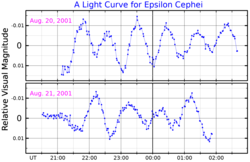Epsilon Cephei
Appearance
| Observation data ICRS )
| |
|---|---|
| Constellation | Cepheus |
| Right ascension | 22h 15m 02.19530s[2] |
| Declination | +57° 02′ 36.8771″[2] |
| Apparent magnitude (V) | 4.15 - 4.21[3] |
| Characteristics | |
| Spectral type | F0 V (Sr II)[4] or F0 IV[5] |
| U−B color index | +0.073[6] |
| B−V color index | +0.277[6] |
| Variable type | δ Sct[3] |
| Absolute magnitude (MV) | +2.13[8] |
| Details | |
| ε Cep Aa | |
Gyr | |
| ε Cep Ab | |
| Mass | 0.57[12] M☉ |
| Database references | |
| SIMBAD | data |
Epsilon Cephei,
apparent visual magnitude of 4.18.[6]
Properties
Physical Characteristics
This is a yellow-white hued,
AU. This dust has a combined mass equal to 6.6% of the Earth's mass.[10]
Binary
There is a faint companion star at an
AU. The probability of a random star being situated this close to Epsilon Cephei is about one in a million, so it is most likely physically associated. If so, then the debris disk is probably circumbinary. The fact that this companion was not detected during the Hipparcos mission may indicate its orbit has a high eccentricity. The companion star has a K-band magnitude of 7.8 and is probably of class K8–M2.[5]
Naming
In
Chinese name for ε Cephei itself is 螣蛇九 (Téng Shé jiǔ, English: the Ninth Star of Flying Serpent)[14]
References
- .
- ^ S2CID 18759600.
- ^ a b c "eps Cep", AAVSO Website, American Association of Variable Star Observers, retrieved 2017-05-07.
- ^ doi:10.1086/319956.
- ^ S2CID 37505271, L12.
- ^ doi:10.1086/110602.
- S2CID 119231169
- ^ S2CID 119257644.
- ^ S2CID 33401607.
- ^ S2CID 11879505.
- S2CID 18475298.
- .
- Centre de Données astronomiques de Strasbourg, retrieved 2017-05-06.
- ^ (in Chinese) AEEA (Activities of Exhibition and Education in Astronomy) 天文教育資訊網 2006 年 7 月 7 日 Archived 2011-05-21 at the Wayback Machine

